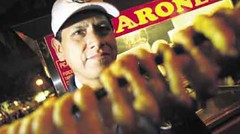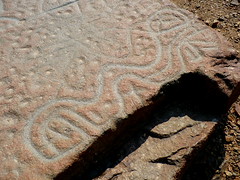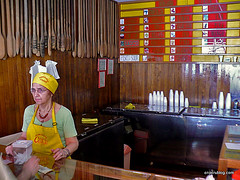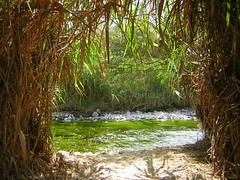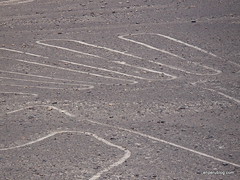In the aftermath of the collapse of the the Moche civilisation in the late 700s A.D. a new civilisation was born. In the late 800s until the early 1000s the Chimú culture began to establish itself, reaching it’s peak in the 1200s and lasting until the 1490s when they were conquered by the Incas.
Category: "History"
Moche: Huaca del Sol y Huaca de la Luna
In the heart of their world, the Moche constructed two truncated pyramids, the gigantic pyramid of the Sun (sol) and the smaller pyramid of the Moon (luna). These pyramids, and the city that spanned between them functioned as their capital.
The Huaca del Sol is by far the largest of the two and is one of two pyramids in Peru thought to possibly be the largest adobe mud-brick construction in the Americas.
The Moche
The Moche (or Mochica) were a civilisation who occupied the northern Peruvian coast between modern-day Lambayeque and Virú and influenced an area that ranged from Huarmey to Piura in the north. They were a collection of peoples with a similar culture and had no central political authority on a grand scale, i.e. they never formed an empire. Primarily farmers and fishers they built irrigation systems to create fertile areas in the desert and created rafts known as the Caballitos de Totora to fish from. But by far their most important legacy was one of art.
Colonial Trujillo
Trujillo is the capital of the region of La Libertad on the northern coast, and is the third largest city in Peru after Lima and Arequipa. This is where the Moche and Chimú civilizations developed between 200B.C. and 700A.D. Its year-round pleasant climate has earned it the title of “Capital of the Eternal Spring”. It has wonderful beaches, including the famous Huanchaco, which are sometimes venues for international surfing competitions. Fishermen still use reed canoes called “Caballitos de Tortora”, made the same way for thousands of years.
San Martín and Peruvian Independence
It was from this balcony in Huaura that in 1820 General Jose de San Martín first declared Peruvian independence from Spain.
Caral – The “Oldest” Civilisation in the Americas
In ancient times, as the peoples of the Nile valley in Egypt and the peoples of the Indus valley in India came together to form cooperative societies, so too did the people of the Supe valley in Peru. In groups of family units of small scale farmers and fishers they began to form systems of government, religion and trade.
An Introduction to Caral
Caral is one of 20 sites thought to be part of the oldest civilisation in Peru and all of the Americas at over 5000 years old. Along the Supe river valley, 5200 years ago, dozens of roaming family groups surviving day to day on what they could find to eat banded together to form a new kind of social group which began pooling their energies and sharing the burden of gathering food and surviving. Here in South America, at the same time as the peoples in the Nile valley were doing the same, one of the first civilisations was formed.
Peru unveils 4000 year old temple
The new discovery filled with murals has been discovered on the north coast.
The ancient temple inside a larger ruin in the Lambayeque valley is home to what is believed to be one of the oldest murals of its kind in the Americas. Video:
Petroglyphs of Pusharo
In his article for the Athena Review, Deyermenjian tells us, “I first encountered petroglyphs in 1984 while my party of highland campesinos and Peruvian adventurers was traversing the Cordillera de Paucartambo, the easternmost range of the high Andes to the northeast of Cusco. We were at an altitude of 13,500 feet when we found ourselves astride a rockhang covered with bas- relief images of llamas and walking humans. All the human figures on the rock were heading in one direction, northeast, toward the tropical forests This site is named Demarcación, whose meaning would doubtless have been understood by Incan peoples of old passing this way”.
Mesa Redonda Fire
The Mesa Redonda fire of the 29th December 2001, just two days before New Year caused deaths in the hundreds. Now, almost six years on, an almost identical tragedy was narrowly avoided, showing that no lessons had been learned.The Mesa Redonda shopping district in downtown Lima was jam-packed full of people, as it normally was, but more so now in the height of shopping season.
Tondero Piurano
The prolonged wait for spring to arrive in Lima has had me thinking of Piura, a sun-drenched paradise rich in creole culture.
The video below is of the famous Tondero dance of Piura.
Poor people, Historic buildings
I still haven’t gotten used to the fact that in Peru the poor are the ones who live in the oldest, most historic and most culturally valuable buildings in the country, and in some cases most of South America.
It’s still strange to me that some of the most run-down, rough and poorest neighbourhoods are also the oldest, and that they are falling apart and no-one seems to care.
What’s strange to Peruvians, especially those who live in these buildings that can be hundreds of years old, is that in most other countries these buildings would be snapped up by the richest of the rich and be worth millions if not tens of million of dollars.



